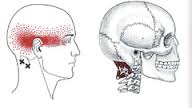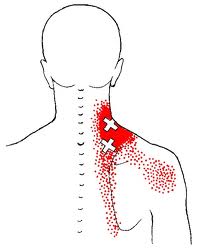What are they?
Trigger points are highly irritable bands of muscle that are causing referred pain and irritation to the body. The key to trigger points is that they present with a predictable pain pattern. These can be in the immediate area of the trigger point or it can be referred further afield and some examples are shown in the images below.
 Headaches occurring in the red zone can be caused by trigger points in the muscle just below the base of the skull. Typically the muscle can get contracted and tight when a computer screen is not at the right height and the user has to tip their eyes slightly upwards.
Headaches occurring in the red zone can be caused by trigger points in the muscle just below the base of the skull. Typically the muscle can get contracted and tight when a computer screen is not at the right height and the user has to tip their eyes slightly upwards.
 Many people will not have
Many people will not have
heard of a muscle called infraspinatus but they will have heard of ‘rotator cuff’ with respect to injuries. Infraspinatus is one of the rotator cuff muscles. It is the muscle that covers the shoulder blade (as indicated by the ‘x’ marks on the far left diagram). However, look where this muscle can refer pain and discomfort to!
It is amazing to think that irritation of muscle in the shoulder blade could potentially be causing pain down the arm as far as the hand. Usually the irritation for this muscle is on the upper arm and more to the front than the back but to feel it further along the limb is not a surprise, just less common. Frequently one of the causes of trigger points in the infraspinatus is the position of the arm at night when sleeping.
 In this diagram a muscle in the neck causes a much more localised pain pattern, with most of the referred pain occurring in the same position as the muscle, in this case the levator scapulae. This is one of the muscles that people feel tension in when they feel their shoulders have moved upwards and are now are stuck just below their ears. Treating this muscle can sometimes feel quite intense so it is always good to let the therapist know if you feel any discomfort during a treatment so that the techniques can be modified to ensure you are comfortable throughout.
In this diagram a muscle in the neck causes a much more localised pain pattern, with most of the referred pain occurring in the same position as the muscle, in this case the levator scapulae. This is one of the muscles that people feel tension in when they feel their shoulders have moved upwards and are now are stuck just below their ears. Treating this muscle can sometimes feel quite intense so it is always good to let the therapist know if you feel any discomfort during a treatment so that the techniques can be modified to ensure you are comfortable throughout.
How do you treat trigger points?
Well massage is very effective in treating this type of soft tissue problem. Frequently, clients might be having a massage and say something like ‘I felt that in my arm’ when you are working their shoulder for example. So although the client may not have persistent pain, it is present. If the warning signs are ignored, that pain may become a constant nagging ache as the trigger point progresses to a more chronic state. As the muscle with a trigger point becomes contracted and not functioning as smoothly as it should, neighbouring muscles start to be affected as their movement is inhibited. This then leads to the spread of tension and discomfort in the body.
Massage works to manipulate the soft tissues to find any trigger points and then use techniques such as compression, myofascial release and soft tissue release to relieve them. Ideally, you want to be able to improve the blood flow to the area, find the key trigger points and treat them. As muscles are sticky and are used to being stuck in a particular position it can take a few sessions to ensure you have treated them all successfully. However, the end result is that you no longer have those muscles causing pain and restrictions in your body. Perfect!
If you would like to book in for a massage contact Susan Harrison on 0759 050 1552 or email susan@powertouchtherapy.co.uk
© Susan Harrison, 2014, Powertouch Therapy
